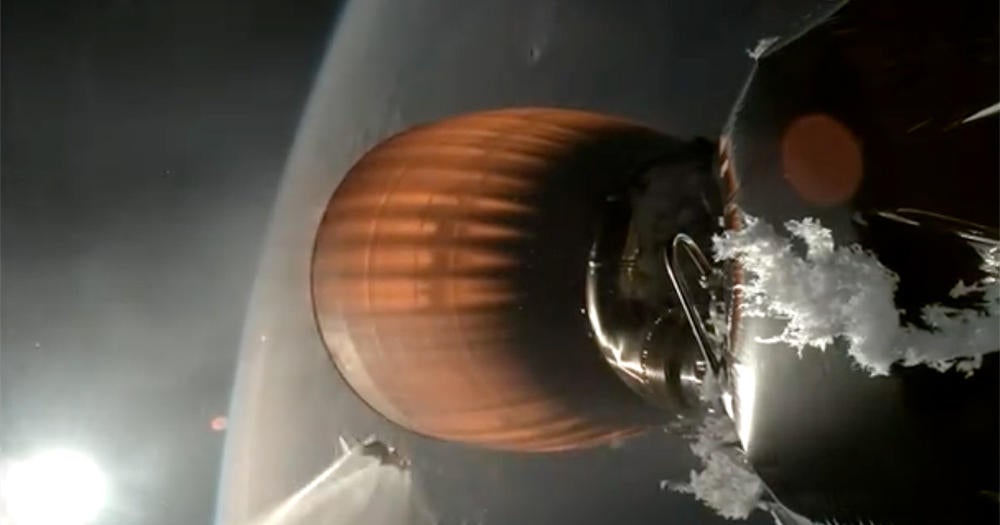SpaceX Falcon 9 rockets grounded pending FAA investigation into Starlink launch failure
The failure of a SpaceX rocket's upper stage engine late Thursday that stranded 20 Starlink internet satellites in a low, non-survivable orbit will be investigated by the Federal Aviation Administration and likely will delay at least one and possibly two upcoming piloted flights of the company's Falcon 9 rockets.
The mishap ended a remarkable string of 344 successful Falcon 9 flights in a row dating back to 2015. The FAA, which licenses commercial launch operations in the United States, said in a statement Friday a joint failure investigation is required before the workhorse Falcon 9 will be cleared to fly again.
"A return to flight is based on the FAA determining that any system, process or procedure related to the mishap does not affect public safety," the FAA said. "In addition, SpaceX may need to request and receive approval from the FAA to modify its license that incorporates any corrective actions and meet all other licensing requirements."
In the meantime, the planned July 31 launch of entrepreneur Jared Isaacman and three crewmates on a commercial flight that will include the first spacewalk by private citizens — Polaris Dawn — is in limbo.
The failure also could impact NASA's plans to launch its next long-duration crew to the International Space Station. Liftoff of the Crew 9 mission currently is targeted for around Aug. 19, but that assumes the SpaceX failure investigation is complete by then and that NASA concurs with the findings.
For his part, Isaacman was not deterred, posting a note on social media that he and his crew, including two SpaceX employees, have full confidence in the Falcon 9.
"SpaceX has an incredible track record with Falcon 9," he said. "I can say from personal experience they are very transparent when issues arise. I have no doubt they will arrive at a cause quickly and ensure the most cost-effective and reliable launch vehicle keeps delivering payload to orbit.
"As for Polaris Dawn, we will fly whenever SpaceX is ready and with complete confidence in the rocket, spaceship and operations."
Given SpaceX's high flight rate and the ability to launch its own payloads — Starlinks — the company may be able to recover in fairly short order. But that will depend on what went wrong, what might be needed to fix it and when the FAA grants a new launch license.
SpaceX founder Elon Musk thanked Isaacman for his support, saying the company "will investigate the issue and look for any other potential near-misses. We are tracking to do more Falcon flights this year than shuttle did in 30 years, the vast majority of which are uncrewed."
"A major advantage of this super-high flight rate is that we can identify and resolve problems that may only occur once every 1,000 flights. This is impossible on a low-flight-rate vehicle."
However it plays out, the incident underscores NASA's ongoing push to certify Boeing's Starliner capsule after its ongoing test flight is complete. The space agency wants two crew ferry ships from different suppliers to keep the International Space Station staffed with NASA astronauts if a failure grounds one or the other.
Boeing has had its own problems with the Starliner, including a series of software and hardware problems that delayed launch by four years. The spacecraft is currently is docked at the space station, but its return to Earth from its first piloted test flight is on hold pending additional analysis of helium leaks and problems with its thrusters.
Prior to Thursday's launch, SpaceX had suffered just one in-flight failure in 354 launches of Falcon 9 and Falcon Heavy rockets dating back to the system's maiden flight in 2010.
A Falcon 9 carrying a Dragon cargo ship loaded with supplies and equipment bound for the International Space Station exploded during launch in June 2015 when an internal strut failed, allowing high-pressure helium to rupture the second stage's liquid oxygen tank.
In a post on his social media platform early Friday, Musk said the Starlink launch failure occurred during an attempt to restart the rocket's second stage Merlin engine to put the craft in the proper Starlink deploy orbit.
He initially said the failure resulted in "an engine RUD," a tongue-in-cheek acronym that stands for "rapid unscheduled disassembly," implying the stage either blew up or at least suffered some sort of structural failure.
But the company said later the failure was the result of a liquid oxygen propellant leak and that the stage survived the aborted engine firing. But while it managed to deploy the Starlinks, they were left in an elliptical orbit with a low point far below a manageable altitude.
"After a planned relight of the upper stage engine to raise perigee — or the lowest point of orbit — the Merlin Vacuum engine experienced an anomaly and was unable to complete its second burn," SpaceX said on its website.
"Although the stage survived and still deployed the satellites, it did not successfully circularize its orbit. This left the satellites in an eccentric orbit with a very low perigee of 135 kilometers (84 miles), which is less than half the expected perigee altitude."
At that altitude, the satellites are being pulled down during repeated passages through the extreme upper atmosphere. Even at full power, the thrust from onboard ion thrusters "is unlikely to be enough to successfully raise the satellites," the company said.
"As such, the satellites will re-enter Earth's atmosphere and fully demise (burn up). They do not pose a threat to other satellites in orbit or to public safety."




